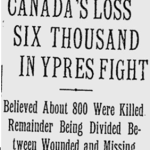Sunday, May 2, 1915
In trenches on Yser Canal
The Battalion War Diarist wrote for this day: “For particulars see summary attached to April War Diary”. [1]
The Ops-Report attached to the War Diary says: – “On Sunday afternoon, May 2nd, about 5:00 p.m. the enemy attacked the Essex Regiment who had replaced the K.O.S.B. on the 14th Bn. right, using poisonous gas, but were driven off by Rifle fire & by the French 75 batteries in the neighborhood. The 14th Bn. stood to arms, but took no active part in the fight.” [2]
 THIS DAY IN RMR HISTORY: The Battalion history elaborates – “About 5 o’clock on the afternoon of May 2nd, a greenish cloud of poison gas, about 40 feet high, poured over the crest of the Pilkem-St. Julien Ridge and fell on the trenches of the Essex Regiment, which had replaced the King’s Own Scottish Borderers on the 14th Battalion right. Three batteries of French ‘75’s, which were in support, immediately lined the crest of the ridge with shrapnel. This fire was beautifully placed and completely crumpled a strong attack which the German infantry attempted to deliver. After the attack had failed, the Essex Regiment reoccupied a front line trench, which the cloud of gas had rendered untenable. On sighting the gas the men of the 14th Battalion fastened small gauze pads over their faces for protection. These pads, soaked in chemicals, had been issued on the previous day, but, fortunately perhaps, a shift in the wind prevented their efficacy from being tested.” [3]
THIS DAY IN RMR HISTORY: The Battalion history elaborates – “About 5 o’clock on the afternoon of May 2nd, a greenish cloud of poison gas, about 40 feet high, poured over the crest of the Pilkem-St. Julien Ridge and fell on the trenches of the Essex Regiment, which had replaced the King’s Own Scottish Borderers on the 14th Battalion right. Three batteries of French ‘75’s, which were in support, immediately lined the crest of the ridge with shrapnel. This fire was beautifully placed and completely crumpled a strong attack which the German infantry attempted to deliver. After the attack had failed, the Essex Regiment reoccupied a front line trench, which the cloud of gas had rendered untenable. On sighting the gas the men of the 14th Battalion fastened small gauze pads over their faces for protection. These pads, soaked in chemicals, had been issued on the previous day, but, fortunately perhaps, a shift in the wind prevented their efficacy from being tested.” [3]
(Special to The Gazette) Ottawa, May 2. With Casualty lists, including Saturday afternoon and today totalling upwards of 300 more officers, non-commissioned officers and privates killed, wounded or missing, there have been heavy additions to the recorded loss among the Canadian forces in the recent terrific fighting in which they won undying glory near Ypres. It is now thought that the Canadian losses in killed, wounded or taken prisoners as a result of that four day engagement will not be short of six thousand and in regard to this the next few days will tell the tale, as every day brings its fresh total.
No further news has been received at the Militia Department as to the fate of the 13th and 14th Montreal battalions which are reported, according to one interpretation of the description of the Ypres battle by the Canadian eye-witnesses, to have been left behind on the retirement of the 3rd Brigade from St. Julien. While this statement would lend credence to the belief that these two battalions had been all killed, wounded or captured, it is pointed out, the eye-witness report states, that the ‘detachments of the 13th and 14th had to be left behind.’ This may mean that only detachments from these regiments suffered this fate while the remainder escaped.” [4]
[1] War Diary, 14th Canadian Battalion, The Royal Montreal Regiment, May 2, 1915. Library and Archives Canada, Ottawa, http://data2.collectionscanada.ca/e/e044/e001089731.jpg
[2] Operation-Report of May 6th, 1915 (Apr 16th – May 5th); War Diary, 14th Canadian Battalion, The Royal Montreal Regiment, May 1915. Library and Archives Canada, Ottawa, http://data2.collectionscanada.ca/e/e044/e001089727.jpg
[3] R.C. Featherstonhaugh, The Royal Montreal Regiment 14th Battalion C.E.F. 1914-1925, Montreal, The Gazette Printing Co., Ltd., 1927, pg. 46.
[4] “Canada’s Loss Six Thousand In Ypres Fight,” The Gazette, Montreal, Quebec, Monday, May 3, 1915, pg. 1, col. 7.

